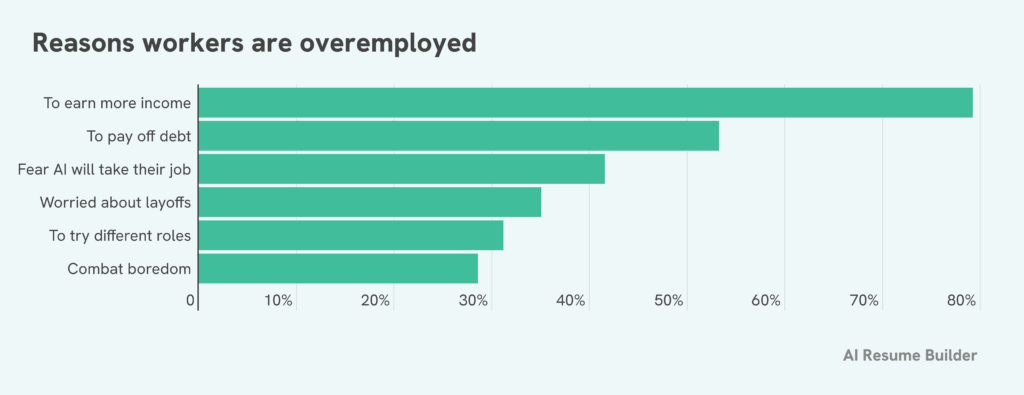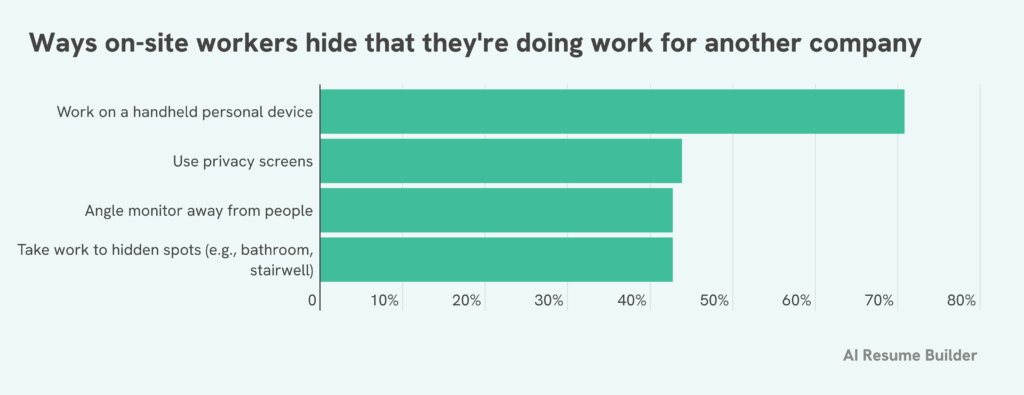Artificial intelligence is enabling a growing number of U.S. workers to secretly manage multiple full-time jobs. AI Resume Builder surveyed 3,283 full-time employees and discovered that 1 in 20 workers hold more than one full-time job, with most relying heavily on AI tools to maintain productivity and avoid detection.
Key findings:
- 64% of workers with multiple full-time jobs use AI to manage the workload; the majority say it plays a major role in their ability to hold down multiple roles
- Gen Z has the highest rate of overemployment (working multiple jobs simultaneously), with nearly 1 in 5 Gen Z men holding multiple jobs
- Most overemployed workers log fewer than 50 hours per week across both roles
- Nearly half of workers juggling multiple jobs have household incomes over $100k
- Desire to earn more money and pay off debt are top motivators for overemployment
64% of Overemployed Workers Use AI To Juggle Workload
About 64% of workers holding multiple full-time jobs report using AI tools to help manage their workload. Overemployed Gen Zers are even more likely to use AI (75%). Among those using AI, 18% say it plays an essential role, and they could not manage multiple jobs without it. Another 42% describe AI as playing a major role in helping them juggle responsibilities, while 30% say it’s useful but not critical.
The most common uses of AI include summarizing documents (65%), summarizing meetings (62%), writing or responding to emails (62%), and organizing schedules (60%). Additionally, more than half (58%) of overemployed workers use it for automating tasks, and 57% for generating reports or presentations.

The majority of workers with multiple full-time jobs report working fewer than 50 hours per week across both roles. Specifically, 26% say they work under 40 hours total, another 26% report 41 to 50 hours, and 25% work 51 to 60 hours per week. Still, a notable 23% say they are working more than 60 hours each week.
Nearly 1 in 5 Gen Z men are overemployed
Men are more likely than women to hold multiple full-time jobs, with 4.4% of men doing so compared to 2.8% of women.
Younger workers are significantly more likely to be overemployed. Gen Z reports the highest rate at 12%, followed by Millennials at 5%, Gen X at 2%, and Boomers at just 0.3%. Specifically, about 17% of Gen Z men report working multiple full-time jobs.
Nearly half of workers juggling multiple jobs have household incomes over $100K.

3 in 10 Hold Multiple Jobs Because They’re Afraid of Being Replaced by AI
Most respondents say they took on multiple full-time jobs to earn more income (75%) or pay off debt (51%), while others cite fear of layoffs (28%), fear of AI replacing them (30%), company fit testing (29%), and boredom (26%).

Respondents shared additional insights into their experiences, highlighting both benefits and challenges:
- “It’s more income, but the effort is also greater. AI plays a crucial role in helping me manage my time.”
- “Managing multiple jobs builds skills and financial stability, but it requires careful balancing to avoid burnout.”
- “I can do both jobs fairly seamlessly. The second job doesn’t take much bandwidth. It can be put away from time to time.”
- “It’s very hard, but I get paid well for multiple jobs. This gives me the freedom to do whatever I want.”
- “The benefits are working on different projects. It feels like the days are exciting and very short! The challenge is managing multiple calendars, especially when changes come up.”
- “The benefit is obviously the money. The challenge is scheduling and having time for my family.”
“Younger generations are more likely to see working multiple jobs as not only possible but positive, whereas older generations may see it as unethical and impractical,” says AI Resume Builder’s Career Advisor Rachel Serwetz. “Gen Z’s comfort and familiarity with AI also gives them an edge in productivity, efficiency, and managing workloads, whereas older workers have been slower to embrace these tools.”
Many Overemployed Employees Work Second Job While On-Site at First
Only 25% of respondents say both of their jobs are in-person. For the majority, at least one job is fully remote or hybrid.
Among those balancing a hybrid or remote job with an on-site role, most (57%) report actively performing tasks for their second job often or all the time while physically present at their primary workplace. An additional 19% say they sometimes do.
Workers primarily use handheld devices (71%), privacy screens (44%), or angled monitors (43%) to discreetly manage their second job on-site. Additionally, 43% frequently step away to private areas like bathrooms or hallways to avoid detection.

When juggling meetings across multiple roles, overemployed workers commonly rely on AI tools (51%) and calendar blocking (45%) to stay organized. Others request scheduling changes (38%), attend multiple meetings simultaneously (29%), or skip non-essential meetings altogether (26%).
“Full-time salaried employees are expected to dedicate their full workday to one employer, and using employer resources for another job is especially inappropriate. Most contracts require disclosure of outside work to avoid conflicts and productivity issues. While financial pressures can make dual employment tempting, it’s not a recommended or ethical career strategy,” says Serwetz.
Methodology
This survey launched in July 2025 and was commissioned by AIResumeBuilder.com and conducted online by the polling platform Pollfish. Overall, 3,283 full-time U.S. workers were surveyed.
